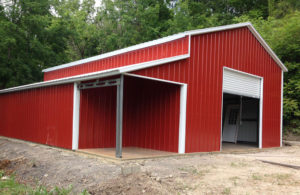
Metal barns stand as enduring symbols of agricultural innovation, embodying the progress and adaptability of farming practices over the years. As we trace the evolution of metal barns from their humble beginnings to their modern incarnations, we gain insight into the changing needs of farmers and the advancements in construction technology. This article takes you on a journey through time, exploring how metal barns have transformed from simple structures to versatile agricultural assets.
Past: Utilitarian Beginnings
The concept of metal barns emerged as a response to the limitations of traditional wooden barns. In the late 19th and early 20th centuries, farmers sought more durable alternatives that could withstand the harsh realities of rural life.
Metal, specifically steel, offered unparalleled strength and resistance to environmental factors like pests, fire, and rot. These early metal barns were characterized by their straightforward designs, with gabled roofs and open layouts optimized for housing livestock, storing crops, and housing equipment.
Functionality was paramount, and metal barns fulfilled the essential role of protecting valuable assets.
Mid-Century Innovation
As farming practices evolved and mechanization gained prominence, so did the design and purpose of metal barns. The mid-20th century witnessed the introduction of pre-engineered metal barn kits, revolutionizing the construction process.
These kits enabled farmers to erect barns quickly and efficiently, further emphasizing the utilitarian nature of metal structures.
Additionally, advances in galvanization and protective coatings prolonged the lifespan of metal barns, solidifying their reputation as durable and low-maintenance options.
Present: Versatility and Customization
In the modern era, metal barns have transcended their utilitarian roots to become adaptable and customizable structures. Today’s metal barns come in an array of sizes, shapes, and designs, catering to diverse agricultural needs.
Farmers can now incorporate climate control systems, advanced ventilation, and insulated panels to create optimal environments for livestock and crops. The integration of sustainable practices, such as incorporating solar panels and rainwater harvesting, showcases the ongoing commitment to environmental consciousness.
Furthermore, aesthetics have gained significance, with metal barns now offering a range of finishes, colors, and architectural features to complement the surrounding landscape.
Whether used as functional farm buildings or transformed into charming event spaces, modern metal barns blend practicality with visual appeal.
The evolution of metal barns reflects the dynamic nature of agriculture and construction. As technology continues to advance and sustainable practices become more integral to agriculture, it’s likely that the evolution of metal barns will persist, ensuring they remain a vital part of the agricultural landscape for generations to come.
